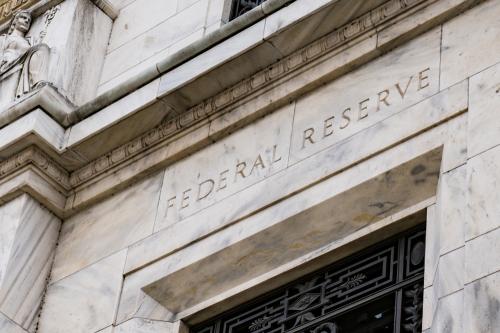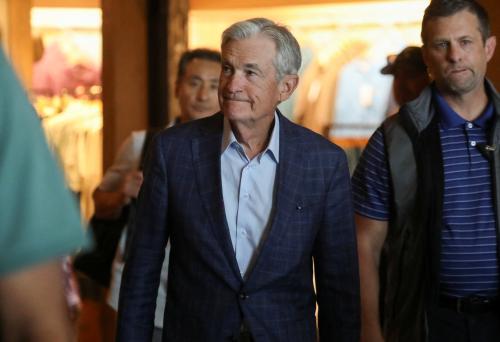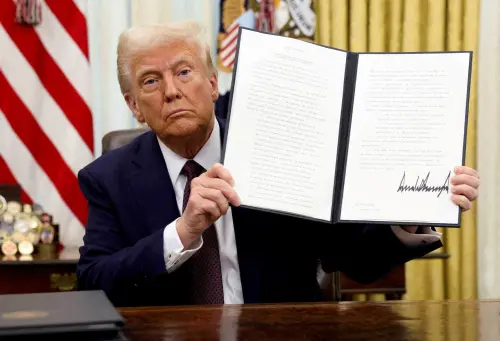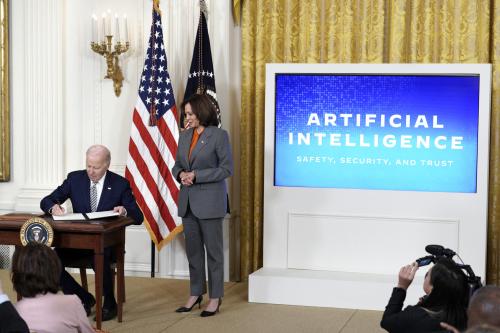Some in Congress have proposed a repeal of the Federal Reserve’s authority to pay interest on bank reserves. This post explains why the Fed pays interest on reserves and why the concerns raised about such payments are wrong.
What are bank reserves?
Reserves are deposits that banks hold at the Fed. Banks hold such deposits because they need them to make payments, both for themselves—when they make loans or purchase securities—or for customers writing a check on their bank account, for instance. In addition, banks hold reserves as insurance against a sudden need for liquidity if financial markets are disrupted or the banks face unexpectedly heavy withdrawals. (Banks have not been required by regulation to hold reserves at the Fed since 2020.)
While each bank can adjust its holdings of reserves, the total amount of reserves in the system is set by the Fed through its actions. The Fed can increase the aggregate level of reserves by purchasing securities (such as U.S. government bonds) in the open market and paying for them with newly created reserves. Similarly, it can decrease reserves by selling securities.
If the banking system has to hold the reserves that the Fed supplies, why does the Fed pay interest on them?
Prior to the Global Financial Crisis of 2007-09, the Fed did not have the authority to pay interest on reserves. It implemented monetary policy by adjusting the supply of reserves. By reducing the supply of reserves, the Fed could make them scarce, leading banks to bid up interest rates to obtain the level of reserves they needed to meet reserve requirements. Other short-term interest rates would move up as well, slowing borrowing and the pace of economic growth while putting downward pressure on inflation. Conversely, the Fed could increase the supply of reserves, which would lead banks to reduce interest rates as they tried to shed reserves to limit holdings of non-interest-bearing assets.
The pre-crisis arrangement had two drawbacks. First, by forcing banks to hold a non-interest-bearing asset (reserves), the Fed was essentially imposing a tax on banks. To recoup the cost of that implicit tax, banks presumably charged somewhat higher rates on loans and paid somewhat lower rates on deposits, disadvantaging their customers. Second, to avoid the implicit tax, banks engaged in wasteful activities to reduce their reserves. For example, banks developed systems to move funds at the end of the day from accounts with higher reserve requirements to accounts with lower reserve requirements. These systems used real resources, which imposed costs on the banks and, consequently, on their borrowers and depositors. For these reasons, the Fed argued for many years that it should have the authority to pay interest on reserves. (See, for example, Kohn, 2004.) To eliminate these costs, Congress voted in 2006 to allow the Fed to pay interest on reserves, but pushed the effective date to 2011. (For more on these issues, see Bernanke and Kohn, 2016.)
During and after the financial crisis, the Fed undertook large-scale asset purchases (Quantitative Easing, or QE) to restore market functioning and support the recovery, paying for the securities with increases in reserves. The result was a substantial rise in reserves (Figure 1), which drove short-term interest rates to near zero. With modest adjustments in the supply of reserves no longer sufficient to influence short-term interest rates, Congress accelerated the effective date of the Fed’s authority to pay interest to October 1, 2008.
Since that time, the Fed has implemented policy largely by raising and lowering the rate it pays on reserves. That rate serves as a rough floor on short-term interest rates because banks will not lend funds to others at a rate below the one they can obtain from the Fed. (For additional information on the Fed’s policy implementation since the financial crisis, see Ihrig, Meade, and Weinbach, 2015.) Many other central banks, including the European Central Bank, the Bank of England, and the Bank of Japan, also use the payment of interest on reserves as a tool to implement policy. This approach proved effective when it came time for the Fed to raise rates in late 2015 (see Anderson, Ihrig, Styczynski, and Weinbach, 2017). It allowed the Fed to buy Treasury securities to ease market crises in 2019 and 2020 without losing control of the short-term interest rate. And following the substantial additional QE undertaken in response to the COVID pandemic, interest on reserves worked well when the Fed increased interest rates in 2023 and 2024.
But the global financial and COVID crises are over, so why continue paying interest on reserves?
As the Fed unwound QE between 2017 and 2019 by declining to replace maturing U.S. Treasuries in its portfolio, reserves fell from their earlier highs. At the time, the Federal Open Market Committee considered whether to return to implementing policy with relatively scarce reserves, as it had done prior to the financial crisis, or continue with the “ample” reserves system used since the financial crisis. In January 2019, the FOMC announced that it would continue to use an ample reserves system, with changes in the interest rate paid on reserves used to set short-term interest rates in line with policy objectives. This decision reflected the Committee’s judgment that the ample reserves system would provide appropriate control over the federal funds rate (the rate that banks charge each other for overnight loans, and the Fed’s primary benchmark) in a variety of market environments, with effective transmission to other short-term rates and broader financial markets. In addition, policy makers judged that a return to the pre-crisis system would likely require large and frequent adjustments in reserves, which might prove difficult in some circumstances. Finally, a higher level of reserves could help stabilize the banking system in the event of significant funding strains (see Bostic, 2019).
What arguments are made by members of Congress who want to prohibit the Fed from paying interest on reserves?
Those who argue for ending the payment of interest on reserves note that the Fed has paid hundreds of billions of dollars to banks in recent years and is likely to continue to pay substantial amounts to banks over coming years. They suggest that ending the payment of interest on reserves would save the Fed—and so ultimately the Treasury—hundreds of billions of dollars over time, as well as eliminate an unfair windfall for banks. These arguments reflect a lack of understanding about the operations of both the Fed and the banking system.
Is the payment of interest on reserves a net cost to the Treasury?
Not over the long run. While a larger Fed balance sheet means that the Fed is supplying more reserves to banks, on which it pays interest, it also means that the Fed is holding more government securities purchased with those reserves, and it earns interest on those. Thus, the implication for Fed profits (which are turned over to the Treasury after paying the Fed’s expenses)—and so, the budget deficit—depends on the net interest earned or paid by the Fed.
The interest rate paid on reserves is a short-term rate—reserves are held overnight—while the rate on the Fed’s securities holdings is a mix of short, intermediate, and long-term rates, depending on the particular portfolio of securities the Fed is holding. Thus, Fed interest income and expense (including interest payments to banks) can differ significantly in some periods. Indeed, the Fed had large profits and made large remittances to the Treasury for a number of years following the financial crisis and again in the immediate aftermath of the pandemic, but it has had substantial losses recently, reflecting the rapid rise in short-term rates put in place to combat the post-COVID inflation (Figure 2). But this is a temporary condition. Over time, yields on long-term securities have somewhat exceeded, on average, those on short-term debt as investors arbitrage across instruments with different maturities to achieve roughly equal risk-adjusted returns. As a result, the effects of a larger Fed balance sheet on interest payments to banks and interest receipts on securities should be roughly offsetting, leaving Fed income and the federal budget deficit about unchanged. (For a discussion of the potential implications of QE for Federal Reserve income and the federal budget, see English and Kohn, 2022.)
Is the payment of interest on reserves an unfair windfall for banks?
No. Banks have to fund their holdings of reserves with deposits or borrowing, just as they do with other assets that they hold. And banks pay interest and face other costs associated with those sources of funding. The key issue, then, is how the interest on reserves compares to the banks’ cost of funding. There are three reasons to believe that the difference between the two is small. First, the rate paid on reserves is very close to the rates on a range of other short-term instruments with which banks and others can borrow and invest. For example, over the past five years, the interest rates paid on 1-month Treasury bills and 1-month commercial paper have moved very closely with the rate paid on reserve balances (Figure 3). Second, the Fed’s payments of interest on reserves have increased immensely in recent years, reflecting both a higher level of reserves and higher interest rates, but that increase does not appear to have affected bank profitability. Specifically, between 2021 and 2024, payments of interest on reserves increased by more than $150 billion, but bank profits changed little, remaining near $300 billion, suggesting that higher funding costs offset the rise in interest income. Finally, any individual bank can increase its holdings of reserves by raising its deposit rates to attract new funds and leaving the funds in its reserve account at the Fed. Thus, if the rate paid on reserves offered banks an excessive profit, increased competition among banks for deposits would push up bank funding costs, offsetting that profit.
What would happen if the Fed could no longer pay interest on reserves?
If Congress repealed the Fed’s authority to pay interest on reserves, the Fed would turn to other tools to implement monetary policy. In the short run, the Fed probably would make greater use of reverse repurchase agreements to provide a floor for short-term interest rates. In a reverse repurchase agreement, the Fed essentially borrows short-term in financial markets; counterparties will not lend to anyone else at a rate lower than the Fed is offering. Reverse repurchase agreements have effects—and costs—similar to those of the payment of interest on reserves. Thus, ending interest on reserves would leave Fed interest payments little changed, and so would have little effect on Fed profits and so on the federal budget.
If the Fed were unable to pay interest on reserves, it might reconsider its decision to implement monetary policy with a large balance sheet, and so move, over time, back to a smaller balance sheet and policy implementation using a scarce reserves framework. (Shifting back to a scarce reserves system quickly would not be feasible because the huge sales of Treasuries required would disrupt the Treasury market. In the interim, the Fed might find it more difficult to control short-term interest rates.) Such a shift would lead the Fed to decrease its holdings of securities, reducing interest income and largely offsetting, on average, the savings from not paying interest on reserve balances, as discussed above. The net effect on Fed income, and so on the federal budget, would depend on banks’ residual demand for non-interest-bearing reserves. That demand would surely be small—vastly smaller than the level of reserves today. Moreover, the lack of interest on the reserves that banks chose to continue holding would still be an implicit tax on bank intermediation, falling on bank customers and inducing wasteful avoidance efforts. Such a change in policy implementation would also require the Fed to give up the benefits it saw to operating with an ample reserves framework, including potential improvements in financial stability from more liquid bank balance sheets.
What’s our bottom line?
To the extent that those urging an end to the payment of interest on reserves see that change as saving the government money or eliminating an unfair benefit for banks, they are very likely to be disappointed. The payment of interest on reserves is a useful tool for the implementation of monetary policy, employed by many central banks around the world. It does not provide a windfall for banks, nor is it likely to have a significant net cost for the government over time. There is debate over whether the benefits of a larger Fed balance sheet and an ample reserves framework for policy implementation and crisis management outweigh the costs. (For a critical view, see Nelson, 2025.) But resolving that question should not be driven by misunderstandings regarding the effects of interest payments on government finance or bank profits.
The Brookings Institution is committed to quality, independence, and impact.
We are supported by a diverse array of funders. In line with our values and policies, each Brookings publication represents the sole views of its author(s).








Commentary
Op-edWhat would happen if Congress repealed the Fed’s authority to pay interest on reserves?
September 10, 2025